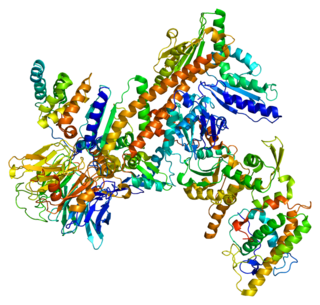
P2Y purinoceptor 1 is a protein that in humans is encoded by the P2RY1 gene.

Estrogen-related receptor gamma (ERR-gamma), also known as NR3B3, is a nuclear receptor that in humans is encoded by the ESRRG gene. It behaves as a constitutive activator of transcription.

Frizzled-4 is a protein that in humans is encoded by the FZD4 gene. FZD4 has also been designated as CD344.

S100 calcium-binding protein A12 (S100A12) is a protein that in humans is encoded by the S100A12 gene. It is also known as calgranulin C and belong to the S100 protein family

Paired box gene 4, also known as PAX4, is a protein which in humans is encoded by the PAX4 gene.

AP-1 complex subunit mu-2 is a protein that in humans is encoded by the AP1M2 gene.

Class E basic helix-loop-helix protein 40 is a protein that in humans is encoded by the BHLHE40 gene.

ATP-binding cassette sub-family A member 7 is a protein that in humans is encoded by the ABCA7 gene.

BRCA1-A complex subunit BRE is a protein that in humans is encoded by the BRE gene.

Zinc finger protein 318 is a protein that in humans is encoded by the ZNF318 gene.

Zinc finger protein 295 is a protein that in humans is encoded by the ZNF295 gene.

Sclerostin domain-containing protein 1 is a protein that in humans is encoded by the SOSTDC1 gene.

Serine/threonine-protein kinase LMTK1 is an enzyme that in humans is encoded by the (AATK) gene.

Abhydrolase domain-containing protein 2 is a serine hydrolase enzyme that is strongly expressed in human spermatozoa. It is a key controller of sperm hyperactivation, which is a necessary step in allowing sperm to fertilize an egg. It is encoded by the ABHD2 gene.

Actin-related protein 3B also known as ARP3-beta is a protein that in humans is encoded by the ACTR3B gene. Pseudogenes of this gene are located on chromosomes 2, 4, 10, 16, 22 and Y. Alternative splicing results in multiple transcript variants and protein isoforms.

Sprouty-related, EVH1 domain-containing protein 3 also known as Spread-3 is a protein that in humans is encoded by the SPRED3 gene.

Solute carrier organic anion transporter family, member 2A1 also known as the prostaglandin transporter (PGT) is a protein that in humans is encoded by the SLCO2A1 gene.

UBX domain protein 6 is a protein in humans that is encoded by the UBXN6 gene.

DnaJ (Hsp40) homolog, subfamily C, member 9 is a protein that in humans is encoded by the DNAJC9 gene.

Leucine rich repeat containing 15 is a protein that in humans is encoded by the LRRC15 gene.

















